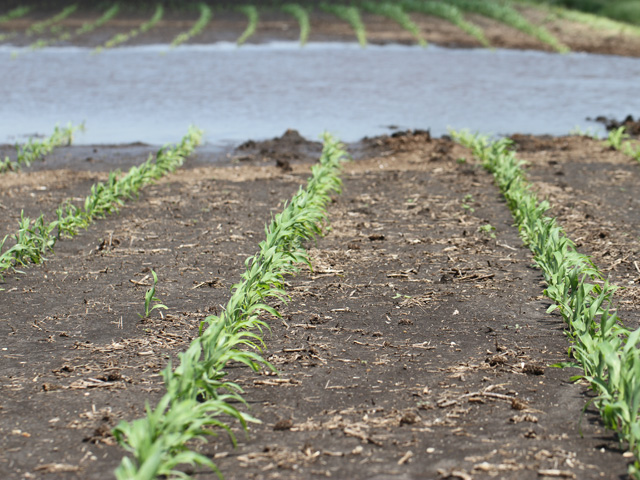Factors to Consider With Supplemental N
Wet Field Conditions Could Lead to Issues With Lost Nitrogen Fertilizer
OMAHA (DTN) -- With all the rain this spring across the Corn Belt, there is some question as to how much nitrogen fertilizer is available to corn plants. The excess moisture has led to nitrogen deficiencies in some fields and unevenness across fields.
This situation could lead some corn producers to consider applying supplemental nitrogen fertilizer. However, before farmers apply more nitrogen, experts advise examine the situation fully.
IS MORE N NEEDED?
In a University of Minnesota Extension Nutrient Management podcast, "Supplement nitrogen fertilizer: Is it time to pull the trigger?" from June 17, four specialists discussed the issue in-depth (https://blog-crop-news.extension.umn.edu/…).
Dan Kaiser, University of Minnesota Extension nutrient management specialist based in St. Paul, said he believes there will be a fair number of fields in south-central Minnesota with some supplemental nitrogen fertilizer applied soon. Growers will want to take a closer look at all their cornfields to see which might benefit from some additional nitrogen.
There are some online supplemental nitrogen fertilizer decision tools that could help farmers decide whether they should apply more nutrients. These tools are more of a qualitative assessment of your need for supplemental nitrogen, he said.
"In most cases, we only recommend about 30 pounds of additional (nitrogen) when corn follows soybeans and somewhere between 30 to 70 pounds when corn follows corn," Kaiser said.
Growers need to consider best management practices and what exactly is recommended, particularly the three Rs that are not the Right Rate -- the Right Source, at the Right Placement, at the Right Time.
DRAINAGE TILES MATTER
Fabian Fernandez, University of Minnesota Extension nutrient management specialist also based in St. Paul, suggests farmers need to consider yield potential when thinking about supplement nitrogen fertilizer application. Look at where the field is located and really examine if the crop is going to benefit from that nitrogen application, he said.
Another consideration would be if the field that needs supplemental nitrogen fertilizer has drainage tile or not.
P[L1] D[0x0] M[300x250] OOP[F] ADUNIT[] T[]
Fernandez said they have done some studies with replicated trials in the same location with the same soils with and without tile drainage over 10 years. Several years of the study included wet springs similar to this spring, he said.
"And in those really wet seasons, we noticed that the maximum return to nitrogen for those specific years between drained and undrained conditions was anywhere from 20 to 30 pounds of nitrogen," Fernandez said.
Fernandez recommended farmers be cautious in applying supplemental nitrogen. A full rate will not need to be applied, he said.
THINK ABOUT OVERALL N RATES
Brad Carlson, a University of Minnesota Extension educator based at the Mankato Regional Office, said the overall nitrogen application rate should be taken into consideration when considering supplemental nitrogen.
He recently talked to a corn producer who had applied a rate that was fairly high for corn following soybeans. Carlson said he told the producer he could lose about a quarter of his nitrogen and still have enough for the corn crop.
Some producers he has talked to were planning to sidedress corn, so they only applied about half of their nitrogen fertilizer needs. While those fields do not look very good right now, they probably have lost very little nitrogen because there wasn't much out there in the first place, he said.
"Maybe in some circumstances they'd want to bump that up an extra, say, 20 pounds, but in some cases, that 80 pounds applied last fall is probably still adequate, especially if the crop is fairly consistent," Carlson said.
Farmers also need to consider that many of these "ugly" fields won't be able to reach their full potential anymore. With top-end yield potential reduced, there's really no reason to fertilize the crop for that high target, he said.
RESEARCH GUIDES N APPLICATION
Jeff Vetsch, a researcher at the University of Minnesota's Southern Research and Outreach Center located in Waseca, said they have done a lot of nitrogen studies where they have looked at rescue or in-season nitrogen treatments. Only a few of those studies showed more than 45 pounds of nitrogen was ever needed, he said.
Even though the corn looks bad right now and may have lost a lot of nitrogen, it really does not take a lot to perk it back up and reclaim its yield potential. It doesn't need 100 to 200 pounds of nitrogen to do this, he said.
Vetsch said he has major concerns about the forecast in the coming weeks for Minnesota, especially the southern part of the state. Already saturated fields don't need another 3 to 4 inches of rain.
This is going to drive denitrification, he said. In addition, these fields are already wet, limiting all field operations.
"So that's very concerning, if that happens," Vetsch said.
CLOCK IS TICKING
Whatever corn producers decide to do with supplemental nitrogen, Carlson said the clock is ticking.
In some cases, the corn is already too tall for some application methods. Some farmers may have drop nozzles or wide drops, but a large percentage of nitrogen is going to be put on in the form of urea, he said.
In some cases, application could be aerial applied or put on with a spin spreader. Regardless, producers would want to use a urease inhibitor in most cases because of the soil moisture conditions, he said.
"We're kind of curious whether the urea is actually going to end up penetrating deep into the soil," he said. "I think there's a potential it could dissolve on the surface and not go anywhere, and so you could experience some volatilization."
The subject of nitrogen availability in wet spring soils was discussed in a recent DTN Retail Fertilizer Trends column: https://www.dtnpf.com/….
Also, see Chris Clayton's update on flooding in parts of Iowa, South Dakota and Minnesota here: https://www.dtnpf.com/….
Russ Quinn can be reached at Russ.Quinn@dtn.com
Follow him on social platform X @RussQuinnDTN
(c) Copyright 2024 DTN, LLC. All rights reserved.






